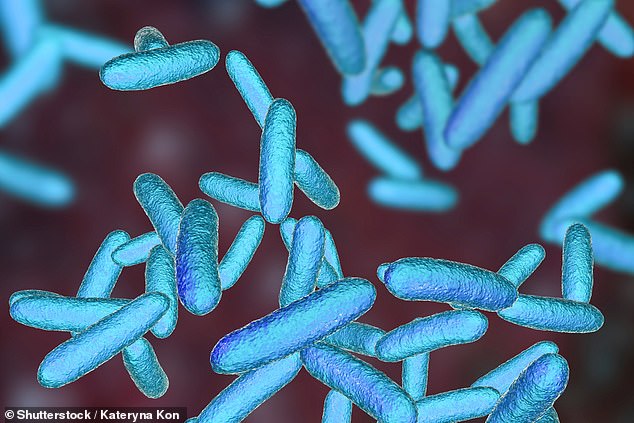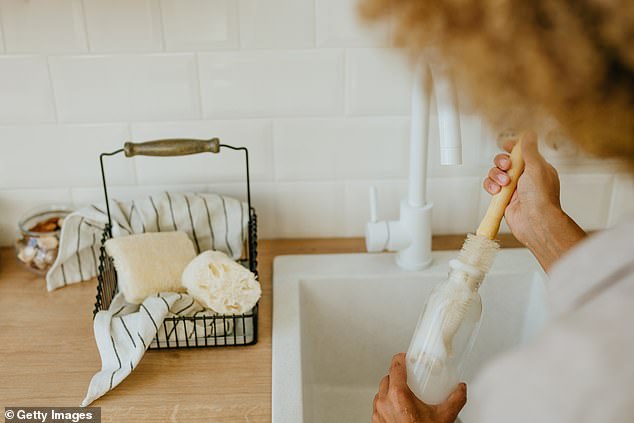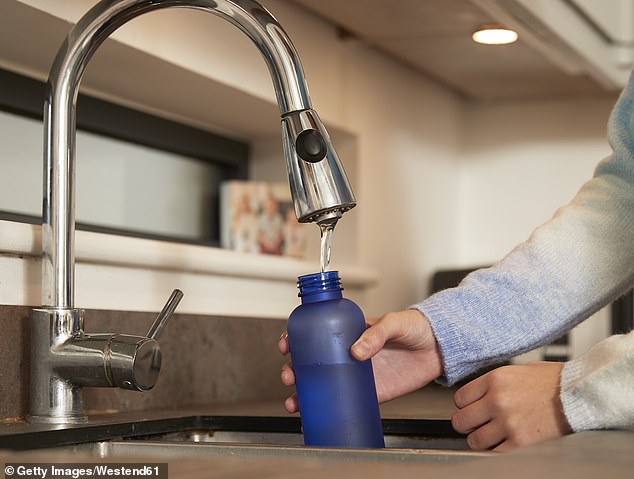When you think of bacteria, you probably picture a fuzzy Petri dish or a well-used toilet seat.
But scientists have revealed that bacteria are probably growing right under our noses on an item we carry everywhere and drink from all day: the reusable water bottle.
A study by an American filtration company WaterFilterGuru.com found that the average reusable water bottle has 20.8 million colony-forming units (CFU) of bacteria.
The worst offenders were bottles with spouts and screw caps that contained 30 million CFU each.
The researchers found two types of bacteria present in the reusable water bottles they tested: bacilli and gram-negative bacilli.
If ingested, gram-negative bacteria can cause infections, while certain types of bacilli can cause serious gastrointestinal problems.
Compared to other germ-filled places in the home, the average reusable water bottle has five times more bacteria than a computer mouse and 14 times more bacteria than a pet bowl that your beloved dog has drooled over.
The most surprising thing is that, according to the study, a reusable water bottle has 40,000 times more bacteria than a toilet seat.
The average reusable water bottle has 20.8 million colony-forming units (CFU) of bacteria (file image)
The longer the water bottle is left at room temperature, the more bacteria will grow.
Fortunately, cleaning your water bottle is relatively easy, and experts recommend washing it once a day.
Dr. Primrose Freestone, associate professor of clinical microbiology at the University of Leicester, suggested in BBC Science Focus recommends washing the bottle with hot water above 60°C, since most pathogens die at this temperature.
“Add dish soap, shake and let sit for ten minutes,” he recommends. “Then rinse it with hot water and let it dry – overnight is best, as thorough drying will also help protect against microbial growth.”
For bottles that are heavily contaminated with microbes, you should add a mixture of half vinegar and half water and let them soak for several days before rinsing them with hot water and letting them dry.
Dr. Freestone added: “To avoid getting sick from your water bottle, it’s best to clean it with detergent after each use.”

The researchers found gram-negative bacilli (pictured) in the reusable water bottles they tested. If ingested, this type of bacteria can cause infections (file image)
“It’s also important to clean lids or accessories, such as straws, as they can also harbor germs.”
More than 60 percent of Americans follow Dr. Freestone’s advice and clean their water bottles one or more times a day, according to the WaterFilterGuru.com study.
But others were less diligent. A quarter of respondents only wash their bottles a few times a week, while more than 10 percent clean them a few times a month.
Members of Generation Z clean their bottles the least, with 16 percent washing them only a few times a month.
Once a water bottle is full, scientists also suggest that it should be placed in the refrigerator to limit the number of microbes.
The type of liquid you pour into the bottle also influences what grows inside it.
Drinks containing sugar may nourish you, but they will also nourish the microbes in the bottle, so it’s best to avoid protein shakes, fruit juices and energy drinks.

The ideal is to wash your water bottle with detergent every day (file image)
Interestingly, carbonated drinks like soft drinks tend to be antimicrobial as carbon dioxide inhibits the growth of pathogens such as E. coli and Pseudomonas aeruginosa.
But whether your bottle is filled with water, protein shakes, or fizzy drinks, it’s best to clean it regularly to prevent bacteria buildup on its interior walls.
If you don’t do this, you’ll probably notice a strange taste or texture the next time you drink from your bottle due to waste products released by a growing army of microbes.
So the next time you’re feeling slightly sick, review your water bottle cleaning habits, as the bacteria and mold growing right under your nose could be to blame.


